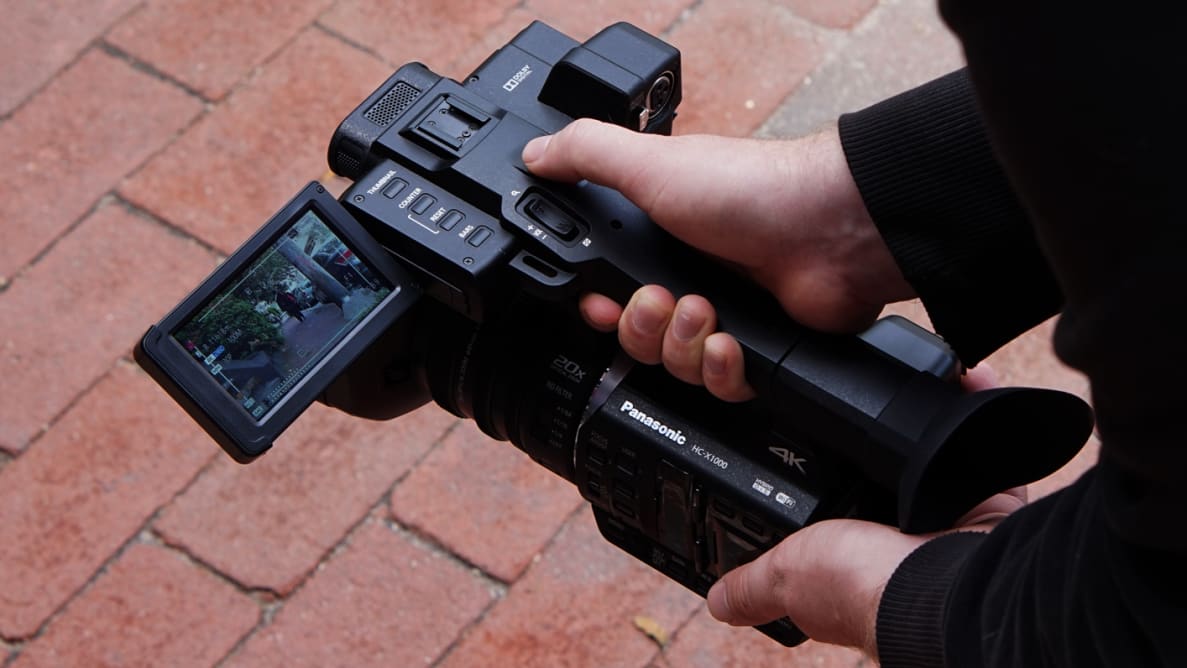That's all well and good, but what about traditional camcorders? While DSLR and mirrorless cameras that are excellent for shooting video seem to garner all the attention, traditional camcorders have been continuing to develop at an equally impressive rate. The New Panasonic HC-X1000 (MSRP $3,499) is just such a camcorder.
While not as extensible as something like the Sony A7S, the HC-X1000 sticks with a tried-and-true form factor that has proven functional for decades. Furthermore, it houses an incredible amount of power, combining dual Venus processing engines, a 1/2.3-inch MOS sensor, and a 20x Leica-branded lens all designed to provide excellent video at resolutions up to 4K/60p.
What's more, the X1000 includes all of this with a full suite of pro-ready controls at a very reasonable price. Panasonic's done this by deftly cutting costs everywhere possible. Though this looks more like a professional device than it actually is, the result is a camcorder that will suit a wide variety of needs at a price point well-suited to even budget-conscious videographers.
Design & Usability
Ready to get to work
If you've ever used an ENG camera, or an old MiniDV camera, then the X1000 should feel instantly familiar. Though it's smaller than shoulder-mounted models, it has a similar form factor with a large rectangular body, a decently-sized (non-removable) top-mounted grip, a hand strap, and a lens barrel long enough to fit multiple manual control rings.
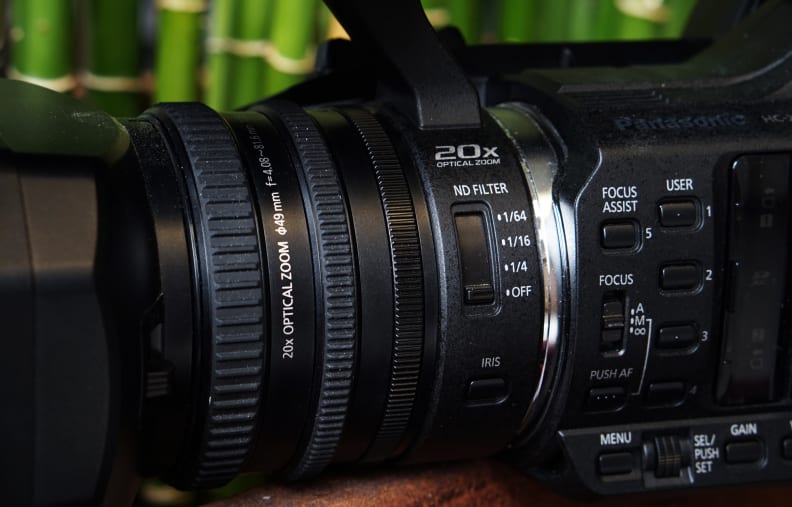
The control rings and functions built directly into the camera save you from having to navigate the digital menu.
As with most cameras of this ilk you've got a wide selection of ports and manual controls on the sides, including controls for gain, white balance, focus, iris, shutter speed, and a small dial for navigation. Behind two plastic doors you'll find dual SD card slots, physical controls for both of the camera's XLR inputs, as well as controls for zebra patterning, stabilization, and toggling information on the display on and off. There's even a handy selector for the camera's built-in ND filter.
There are two primary methods of shooting with the X1000. The most natural way to hold it will be by the hand strap, which is comfortable and gives you easy access to the on/off button, zoom rocker, and record button. The top handle is permanently built right into the body and features an additional zoom rocker and record button (both of which are smaller than the ones on the right side). The articulating touchscreen LCD also flips out from this handle, stowing safely away when not in use.
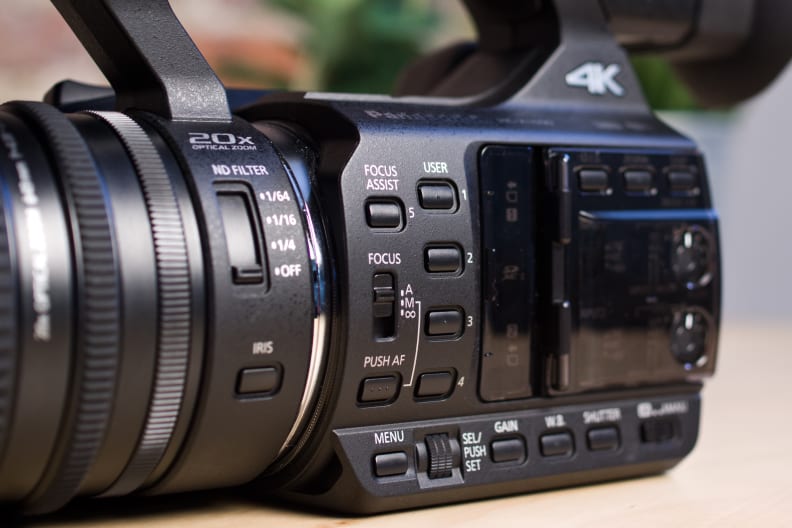
Most of the X1000's manual controls are on the left side of the camcorder.
Shooting with the X1000 is easy thanks to the comfortable placement of the controls. Though some key components like the zoom rockers feel chintzy and hollow, they nicely approximate what you'd expect from any high-end documentary or news gathering camera. This is where the ENG form factor really sings, as a single person can get very smooth focus and zoom pulls as long as you can keep the camera stable. And, while perhaps daunting, the sheer volume of physical controls mean you almost never have to make a trip to the menu.
While the HC-X1000 is loaded with controls, not all are equally-simple to adjust. Settings like focus, iris, and zoom can easily be controlled with lens rings, but others like gain, shutter speed, and white balance are more difficult to manipulate. These settings often require use of the tiny control dial on the left of the camera—and that's not the best method for making adjustments on the fly. Still, the presence of three lens rings for the most important video controls is greatly appreciated.

The X1000 has easy to reach controls for when you're using the handle to shoot from.
The other thing we'd caution here is that while it's lighter than most ENG cameras, the X1000 can still be a bit tiresome over longer shoots. The hand grip is decent, but the camera is just small enough to not need a shoulder mount. We found that you'll probably want to use the EVF to help offset some of its weight when shooting without a tripod.
All in all, the X1000's control setup is more robust than you'd expect given the price point. Normally at this price we will see a few controls cribbed from ENG-type camcorders, but this is more or less the full load. The rings on the lens all provide a healthy level of resistance, as well, making for a camcorder that doesn't feel as nice as a high-end ENG camera, but will certainly be instantly familiar to anyone who has used one in the past.
Features
Just about everything you'd need
When you start outlining all that the X1000 has to offer, it's actually remarkable how little Panasonic has left on the cutting room floor. From a hardware perspective you've got dual SD card slots, a 3.5-inch (1.15m-dot) LCD, and a 20x zoom lens with a 3-stop ND filter and rings for zoom, focus, and iris. For audio there's dual XLR inputs with phantom power, a built-in two-channel stereo microphone, and a headphone jack. It also includes built-in WiFi, letting you use a smartphone as a remote viewfinder and controller.
The only port we'd like to see is a 3.5mm mic jack in addition to the dual XLR inputs, but you could always purchase an XLR-to-3.5mm adapter to solve this issue.
{{ photo_gallery name="things" }}
Once you've recorded video you can output via the camera's HDMI port. It also features analog composite output (not input), making it a functional (if more expensive than you need) choice for older video setups that have yet to be upgraded to digital. For power you've got a 12V DC input that can be used to run the camera and/or charge the battery pack.
The X1000 records all media to the dual SD card slots using MPEG-4/H.264 compression. The beauty of H.264 compression is that it is fully hardware-compatible with pretty much every computer that you'd buy today, making editing a breeze compared to the new (and downright painful) H.265 compression that cameras like the Samsung NX1 are using to record 4K video to SD memory.
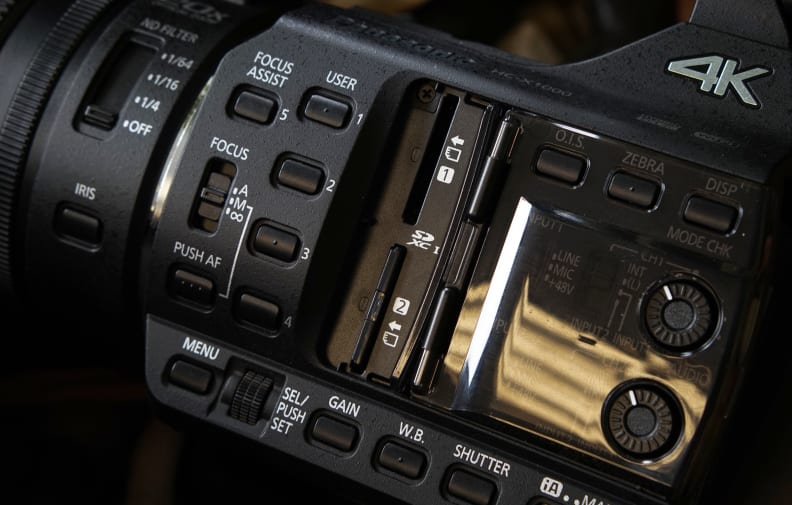
Featuring dual SD ports, it should be more difficult to run out of storage space—even when shooting in 4K.
You will need to pick up newer (and more expensive) UHS-3 SD memory cards, but we have to applaud Panasonic's choice here. Other types of flash media like XQD, CFast, expressP2, and full 2.5-inch SSDs are all either more cumbersome or more expensive (or both). Even with just SD memory, the X1000 can still record in MP4 at variable bitrates up to 200Mbps for 1080/60p and 150Mbps for 4K/60p. Just keep in mind that these are H.264 bitrates we're talking about. H.265 compression would be vastly more efficient, getting better quality while taking up less space, but it's infinitely more time-consuming to edit with today's computer hardware and software.
Speaking of recording frame rates, the X1000 gives you quite a few to choose from. You can record in MP4, MOV, and AVCHD, suiting a wide variety of workflows. In MP4 you can choose from 4K, UHD, and 1080p modes, at all 60, 30, and 24p framerates (as well as PAL variants). In MOV you can choose from the same frame rates, but just at 1080p, while in AVCHD you can select from a range of bitrates with 1080p, 1080i, and 720p resolutions.
Performance
A consumer 4K camcorder, all dressed up
Camcorders generally come in two flavors: single-chip and three-chip. Three-chip sensors split incoming light over three sensors, with one for each channel (red, green, and blue). Single-chip sensors usually have a combination of red-, green-, and blue-sensitive pixels over one sensor, interpolating that information to provide one color signal. The three-chip variety seems to be a dying breed, with more manufacturers focusing on interchangeable lens options (like the Sony A7S or Panasonic GH4), or fixed-lens large-sensor camcorders (like the Sony AX100).
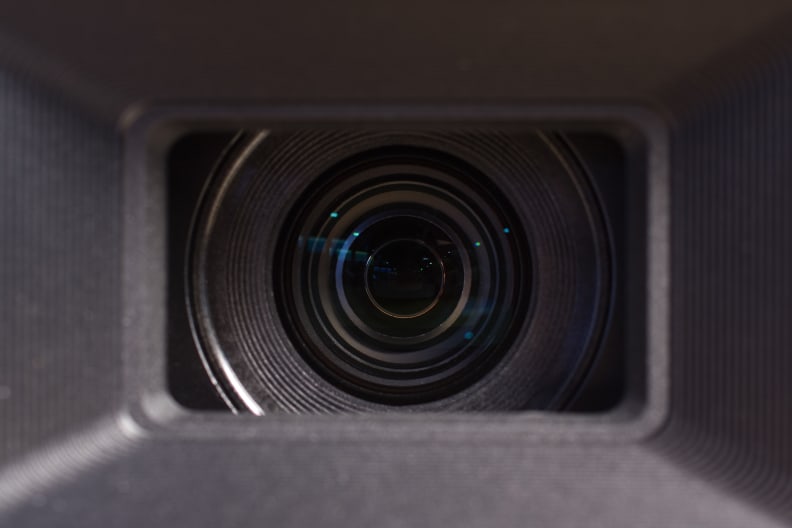
The Leica-branded lens on the X1000 is not removable, but it sports a 20x optical zoom capability.
The HC-X1000 uses just a single (relatively small) 1/2.3-inch sensor with a fixed lens. This gives it the readout speed necessary to record and process 4K/60p video, but it does mean that quality in some situations (notably low light) won't be quite as good as a three-chip camcorder, and without the distinct advantages of a large-sensor video option (like shallow depth-of-field and improved low-light performance).
The biggest area where the HC-X1000 suffered was in color accuracy and noise. While the color accuracy is acceptable—and very consistent across light levels—it's not as tonally rich as it is with three-chip cameras. The video output also looks quite grainy in low light, with a noisy, consistent pattern that isn't aesthetically pleasing. We also found the X1000 provided only limited dynamic range, holding onto about 12 stops total where some 4K cameras can manage 13 or more.

In these shots taken with the Panasonic GH4 and Panasonic HC-X1000 (both at full zoom, maximum aperture) you can see the cinematic, shallow depth of field you miss with the X1000.
Where the HX1000 did deliver was in resolution. As we've seen with other 4K cameras, even small sensors can record extremely sharp 4K footage. In bright light we saw an average resolution of 1350 line pairs per picture height (LP/PH) horizontally and vertically. That's well above what even the best 1080p camcorders can do, so it's a strong result.
Despite having a small sensor, you can push the X1000 in low light if need be. We found it was able to return a usably bright image (50 IRE) with just 6 lux of ambient light. That's a very good result, and the camera's IR-sensitive nightvision mode will let you go even dimmer, though with the usual, obvious green cast over your footage.
Within the 4K-capable sphere, the X1000 is an example of choosing portability and practicality over aesthetics. What you lose in terms of dynamic range and depth of field you gain in the form of razor-sharp image and a 20x zoom lens that is compact, easy to use, and highly functional. This makes the X1000 perhaps a poor choice to realize your artistic visions, but an excellent one if you need to just record consistently high-quality 4K footage without needing a bunch of speciality gear.
Conclusion
A winning all-in-one package.
For its $3,500 price point, the Panasonic HC-X1000 is something of a unique camcorder on the market. And like most (relatively) low-cost camcorders that mimic their higher-end cousins, it's all about compromise. It's single-chip, but it shoots 4K at 60p to SDXC memory cards. It is relatively compact and lightweight, but it has a full suite of audio and video controls. It doesn't have interchangeable lenses, but it does give you a sharp 20x Leica-branded f/1.8 zoom lens with excellent control rings.
Though there are similar cameras on the market right now, there simply isn't a comparable all-in-one solution that also lets you utilize relatively cheap, ubiquitous SD memory. You can gain different advantages that might appeal to your use cases, but you're either going to have to pay quite a bit more, or sacrifice features while paying less.
We were blown away by Sony's AX100, which costs about $1,400 less than the X1000. While it has a simpler build and control set, its 1-inch sensor is fantastic, and the lens it's paired with impressed us with its fast aperture. It's half the cost, but you also get half the max frame rate (4K/30p is where it maxes out) and not nearly as many manual controls or inputs as the X1000.
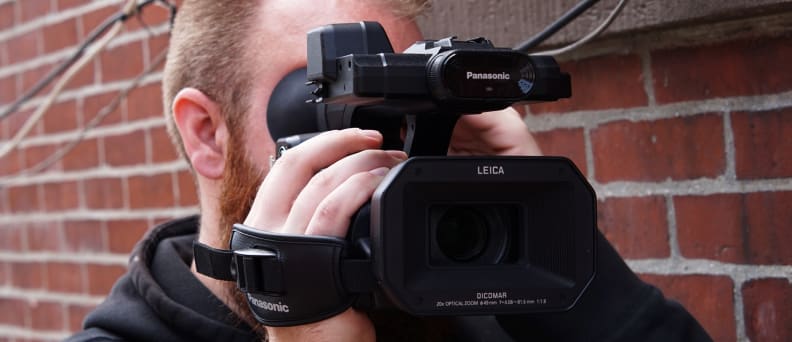
The X1000 is surprisingly light and easy to use without a tripod.
Reach upmarket and things get more expensive, but can net you some really amazing quality and features. If you've got the cash, we're smitten with Blackmagic's Ursa. That's a whole nother kettle of fish, though, and it's not designed to be as straightforward—you'll want to outfit an Ursa to meet your needs with rigging, lenses, and other accessories. The X1000 is a no-brainer in comparison since you only have to buy one thing.
In our opinion, the X1000 will likely appeal to small professional operations that are replacing aging equipment, want to dip into 4K video, and have the knowledge, (and accessories) to take advantage of all that this camcorder has to offer. Houses of worship, journalism schools, and college news departments who aren't already invested into higher-end cinema gear could certainly find a lot to love about this camcorder.
While it might not be the most exciting 4K-packing option you can buy today, it's not designed to be anything more than a straightforward workhorse. Its 1/2.3-inch sensor can't match the aesthetic quality of a full-frame 35mm—or even Micro Four Thirds—image sensor, but it's decent in low light, shoots tack-sharp video, and renders motion quite well thanks to its 4K/60p mode.
Overall, we think Panasonic has done an excellent job of giving the X1000 everything that you'd expect from a high-end camcorder, without the high-end price. The result isn't the best-feeling camcorder we've ever used, but given the cost of entry—and the fact that most comparable 4K cameras can get spendy really fast—we think this is one of the most artful examples of prudent, cost-conscious design we've seen in some time.
By the Numbers
Being a 4K camcorder with a solid lens and sensor combination, the HC-X1000 did a very good job in our performance tests. That being said, the camcorder's $3,500 price tag won't get you the best video quality for the money. There are a variety of DSLR and mirrorless cameras with larger sensors and better lens options that will cost you roughly the same (or a bit cheaper) for a complete package.
What the X1000 has that those DSLRs don't, however, is a whole slew of manual controls, customizable buttons, lens rings, and audio options. So, if you're just looking for the best video quality this isn't the camcorder for you, but if you want a well-rounded package, then the X1000 is spot-on for your needs.
Sharpness Performance
Sharpness is where the X1000 stood out the most in our performance tests. This makes sense, since the X1000 can shoot 4K/60p video at a bitrate of 150Mbps. Those killer specs translate into excellent scores: 1300 line pairs per picture height (lp/ph) horizontal sharpness and 1400 lp/ph vertical. Those numbers are significantly better than what we saw from the prosumer-oriented Sony AX100 (1100 lp/ph horizontal and 1150 lp/ph vertical). If you want impeccably sharp video without shelling out for an expensive lens—this is the ideal camcorder for your needs.
Low Light Performance
While the X1000 soared in our sharpness test, the camcorder struggled a bit in low light. Maybe struggle is being a bit too harsh—the camcorder put up fine numbers in our low light tests—it just didn't excel the way we anticipated. The camcorder matched the Sony AX100 in minimum illumination requirements (needing 6 lux of light to produce a usable image), but it fell to the Sony in our noise test. The X1000's low light image was murkier than we'd hoped, registering 1.5% noise in our test. This is likely due to the camcorder's smallish 1/2.3-inch sensor compared to the Sony's 1-inch imager. You'd also get much brighter and cleaner low light images from a DSLR or mirrorless camera with a full 35mm sensor.
Motion & Detail
The HC-X1000 captures superb motion, thanks to its 4K recording capability and plethora of frame rate options. You can shoot film-like 24p with this camcorder, or you can capture ultra-smooth 60p—both at 4K resolution. Either rate you choose, the results should look sharp, crisp, and artifact-free.
Battery Life
In addition to the copious manual controls and image settings, the HC-X1000 also holds a stark advantage over its DSLR and mirrorless camera competitors in terms of battery life. Recording continuously (without making any on-the-fly adjustments) with the camcorder's 4K/30p MP4 record mode yielded over 400 minutes of battery life (6 hours, 42 minutes). That's rather incredible, particularly for a camcorder as robust as the HC-X1000. Most high-end consumer camcorders come with batteries that last around two hours (the Sony AX100 went for 145 minutes in our test).
Keep in mind, the HC-X1000 is a big camcorder, so it ships with a large 5800 mAh battery pack that is 2-3x the size than what you get with most consumer camcorders or cameras. It's arguable that most camcorders or cameras could replicate this performance if a battery pack of this size was used. But that's not possible with many DSLRs and mirrorless cameras, as most utilize an enclosed battery compartment that can't fit larger battery packs.
Any way you cut it, the HC-X1000's battery performance is a significant plus. The battery pack itself even has a cool capacity check feature that shows you how much battery life remains at the click of a button (it's just a four-step scale, so it won't give you down-to-the-minute details). It should also be noted we shot the HC-X1000's battery life test in 4K using the 100Mbps 30p MP4 setting. Other recording options may drain the battery faster or slower, but they should all be in the same ballpark.
Meet the testers
Jeremy is the video expert of our imaging team and Reviewed.com's head of video production. Originally from Pennsylvania and upstate NY, he graduated from Bard college with a degree in film and electronic media. He has been living and working in New England since 2005.
TJ is the former Director of Content Development at Reviewed. He is a Massachusetts native and has covered electronics, cameras, TVs, smartphones, parenting, and more for Reviewed. He is from the self-styled "Cranberry Capitol of the World," which is, in fact, a real thing.
Checking our work.
Our team is here for one purpose: to help you buy the best stuff and love what you own. Our writers, editors, and lab technicians obsess over the products we cover to make sure you're confident and satisfied. Have a different opinion about something we recommend? Email us and we'll compare notes.
Shoot us an email
